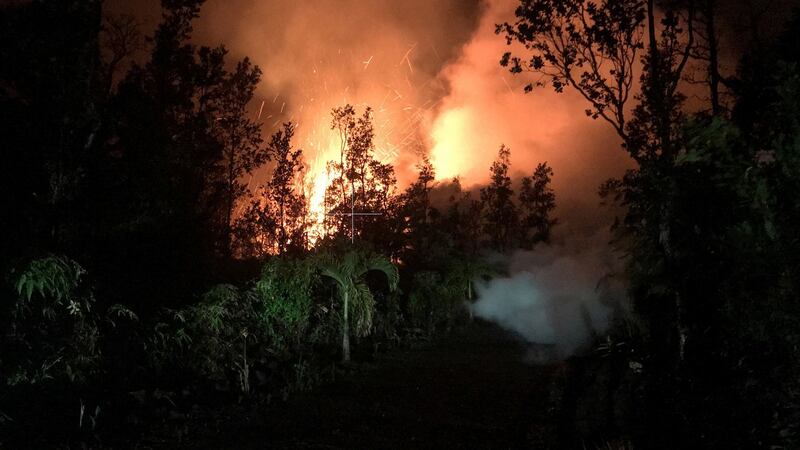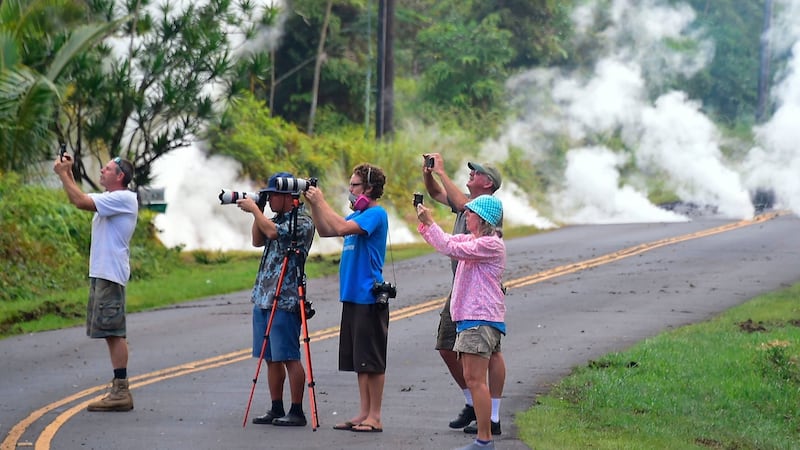Fresh volcanic eruptions after a series of tremors on the southern end of the island of Hawaii have left residents displaced and frightened as authorities evacuated the American state's largest park on Friday and worked to keep people out of two housing developments that had been evacuated.
Following days of small earthquakes, the most powerful, a magnitude 6.9, hit the south flank of the volcano at 12.33pm Hawaii time. No tsunami was expected, according to the Pacific Tsunami Warning Center, but “many areas may have experienced strong shaking”.
That earthquake, which set off rock slides on park trails, forced officials to close down and evacuate Hawaii Volcanoes National Park, which encompasses 133,500 hectares, or 333,000 acres – 13 percent of the Big Island’s total area. Closing the park is a rare occurrence, Jessica Ferracane, a spokeswoman for the park, said on Friday afternoon.
About 2,600 visitors were being evacuated from the park. “It’s a double cruise ship day,” Ferracane said, adding that people were camping in the backcountry. More than two million people visited the park in 2017.
There had been no reports of injuries or death, but by Friday afternoon two homes had been surrounded by lava and officials were warning of dangerous gases. Lava began bubbling up through a new crack in the Kilauea volcano on Thursday evening, but the lava flows, at least as of Friday morning in Hawaii, had been small, said Charles Mandeville of the US Geological Survey.

In all the volcano had at least three new fissures as of Friday afternoon, but Mandeville cautioned that the detected increase in earthquakes, most of which had been small, meant more eruptions were likely. “It’s far from over,” he said.
By Friday nearly everybody had been evacuated from the Leilani Estates and Lanipuna Gardens developments, the areas where the volcano had erupted, Mayor Harry Kim of Hawaii County said.
By 8am in Hawaii the cracks were still spewing sulphur-dioxide gas and debris, but the lava flows had not gone far. The county’s fire department reported that “extremely high levels of dangerous” of the gas had been detected in the evacuation areas. Hawaii police said on Friday they had closed access to the two housing developments “due to hazardous air quality and unstable lava conditions”.

“I never thought I’d ever be faced with this, I’m just shellshocked,” Carl Yoshimoto, said. The 69-year-old has been sheltering at a community centre with his two dogs, Sako and Suki, and his partner since Thursday afternoon. Their house is in Leilani Estates. “As soon as I heard the order to evacuate, I grabbed important paperwork, medications, my wallet – we were out of the house within a half an hour.”
On Thursday evening lava spilled from the crack in the volcano for about an hour and a half, leaving a large smear in a residential area of bushes and trees. Photographs and drone footage showed a line of glowing orange slicing through gardens and white vapour and fumes rising above the trees. Hawaii’s governor, David Ige, issued an emergency proclamation that made state funding faster to access, and he called up the national guard to help emergency workers with evacuation efforts.
Kilauea is the youngest of five volcanoes that make up the island of Hawaii. Mandeville said the signal that there might be more activity was the little earthquakes, which happen when magma moves against rock, in this case, 3km under Earth’s surface. “That’s where the plumbing system is,” he said.
Past volcanic eruptions, some decades ago, have caused lasting damage to parts of the region. “Living on a volcano, everybody has got pretty thick skin. They know the risk,” said Ryan Finlay, who lives in Pahoa and runs an online trade school. “Lava for the most part has flown to the ocean the last 30 years. Everybody gets in a comfort zone. The last couple weeks, everything changed.” – New York Times












